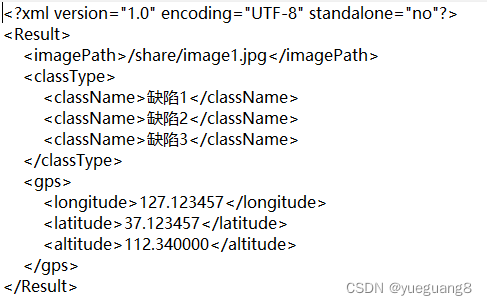TinyXML-2 是一个简单轻量级的 C++ XML 解析库,它提供了一种快速、高效地解析 XML 文档的方式。
1. 下载地址
2. 基本用法
下面将详细介绍 TinyXML-2 的主要使用方法:
2.1. 引入头文件和命名空间
#include "tinyxml2.h"
using namespace tinyxml2;2.2. 解析 XML 文档
XMLDocument doc;
doc.LoadFile("example.xml");
if (doc.ErrorID() != XML_SUCCESS) {
// 处理错误
return;
}2.3. 访问根节点
XMLElement* root = doc.RootElement();2.4. 遍历子节点
for (XMLElement* elem = root->FirstChildElement(); elem; elem = elem->NextSiblingElement()) {
// 处理节点
}2.5. 读取节点属性
const char* attr = elem->Attribute("name");
if (attr) {
// 处理属性值
}-
- 读取节点文本内容
const char* text = elem->GetText();
if (text) {
// 处理文本内容
}
2.7. 除了遍历和读取节点,TinyXML-2 还提供了丰富的节点操作 API,包括创建、插入、删除、克隆节点等。
// 创建新节点并插入到现有节点下
XMLElement* newElem = doc.NewElement("new_element");
root->InsertEndChild(newElem);
// 删除节点
root->DeleteChild(newElem);
// 克隆节点
XMLElement* clonedElem = newElem->DeepClone(&doc);
root->InsertEndChild(clonedElem);2.8. 创建新节点并添加到文档
XMLElement* newElem = doc.NewElement("new_element");
newElem->SetAttribute("attribute", "value");
newElem->SetText("New element text");
root->InsertEndChild(newElem);2.9. 文档操作
TinyXML-2 不仅可以解析现有的 XML 文档,还可以创建新的 XML 文档,并进行保存和打印操作。
// 创建新文档
XMLDocument doc;
XMLDeclaration* decl = doc.NewDeclaration();
doc.InsertFirstChild(decl);
XMLElement* root = doc.NewElement("root");
doc.InsertEndChild(root);
// 保存文档
doc.SaveFile("new_document.xml");
// 打印文档
doc.Print();2.10. 保存 XML 文档
doc.SaveFile("new_example.xml");2.11. 错误处理
TinyXML-2 提供了丰富的错误处理机制。您可以通过检查 doc.ErrorID() 和 doc.ErrorName() 来获取错误编号和错误信息。
if (doc.ErrorID() != XML_SUCCESS) {
printf("Error loading file: %s\n", doc.ErrorName());
return;
}2.12.内存管理
TinyXML-2 使用自己的内存管理机制,无需手动分配和释放内存。所有的内存分配和释放都由库内部完成。
3. 代码示例
生成一个xml,用于保存照片路径,GPS信息及缺陷信息等。
#include "tinyxml2.h"
#include <string>
using namespace tinyxml2;
int SaveInfo(std::string xmlFile, std::string imagePath,
std::string *calssName, int calssNameNum,
double lon, double lat, double alt)
{
XMLDocument* doc = new XMLDocument();
if(doc == NULL)
{
printf("New xml is NULL!\n");
return -1;
}
if(xmlFile.empty())
{
printf("xmlFile path is NULL!\n");
return -1;
}
// 创建xml
const char* declaration ="<?xml version=\"1.0\" encoding=\"UTF-8\" standalone=\"no\"?>";
doc->Parse(declaration);//会覆盖xml所有内容
//创建根目录
XMLElement* root = doc->NewElement("Result");
doc->InsertEndChild(root);
//路径
XMLElement* imagePathNode = doc->NewElement("imagePath");
imagePathNode->InsertEndChild(doc->NewText(imagePath.c_str()));
root->InsertEndChild(imagePathNode);
//缺陷类别
XMLElement* classTypeNode = doc->NewElement("classType");
for(int i = 0; i < calssNameNum; i++)
{
XMLElement* classNameNode = doc->NewElement("className");
XMLText* classNameText=doc->NewText(calssName[i].c_str());
classNameNode->InsertEndChild(classNameText);
classTypeNode->InsertEndChild(classNameNode);
}
root->InsertEndChild(classTypeNode);
//经度
XMLElement* gpsNode = doc->NewElement("gps");
XMLElement* longitudeNode = doc->NewElement("longitude");
XMLText* lonText=doc->NewText(std::to_string(lon).c_str());
longitudeNode->InsertEndChild(lonText);
//纬度
XMLElement* latitudeNode = doc->NewElement("latitude");
XMLText* latText=doc->NewText(std::to_string(lat).c_str());
latitudeNode->InsertEndChild(latText);
//高度
XMLElement* altitudeNode = doc->NewElement("altitude");
XMLText* altText=doc->NewText(std::to_string(alt).c_str());
altitudeNode->InsertEndChild(altText);
gpsNode->InsertEndChild(longitudeNode);
gpsNode->InsertEndChild(latitudeNode);
gpsNode->InsertEndChild(altitudeNode);
root->InsertEndChild(gpsNode);
if(XML_SUCCESS != doc->SaveFile((char *)xmlFile.c_str()))
{
printf("ERROR: Save xml:%s fail\n", xmlFile.c_str());
doc->PrintError();
return -1;
}
printf("Save xmlFile success!\n");
return 0;
}运行结果:

4. 总结
TinyXML-2 是一个功能强大、易用的 XML 解析库,适合各种 C++ 项目使用